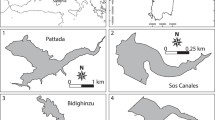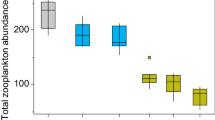Abstract
The occurrence of a sunflower oil spill in 2007 in the Con Joubert Bird Sanctuary freshwater wetland, South Africa, inhibited the growth of sensitive phytoplankton species and promoted that of tolerant species. The algal divisions Chlorophyta and Euglenophyta were well represented in the sunflower oil contaminated water, especially the species Euglena sociabilis, Phacus pleuronectes and Chlamydomonas africana. Young and mature resting zygotes of Chlamydomonas africana were recorded in high abundance at all the sunflower oil contaminated sampling sites. The phytobenthos diversity and abundance were significantly suppressed and negatively associated with low Dissolved Oxygen concentrations and the negative redox potential of the bottom sediment. At the intracellular level, phytoplankton chlorophyll a and b concentrations as physiological variables were more sensitive indicators of the adverse effects of sunflower oil than the 72 h Selenastrum capricornutum algal bioassay conducted.




Similar content being viewed by others
References
American Public Health Association (1980) American Water Works Association and Water Pollution Control Federation. Standard methods for the examination of water and wastewater, 15th edn. American Public Health Association, Washington DC
Anderson JM (1986) Photoregulation of the composition, function, and structure of thylakoid membranes. Annu Rev Plant Physiol 37:93–136
Baker AL, Baker KK, Tyler PA (1985) A family of pneumatically-operated thin layer samplers for replicate sampling of heterogeneous water columns. Hydrobiologia 22:107–211
Begg GW (1990) Policy proposals for the wetlands of Natal and Kwazulu. Natal town and regional planning commission. Report 75. Pietermaritzburg. Z.A
Bird DF, Kalff J (1989) Bacterial grazing by planktonic algae. Science 231:493–495
Björkman O, Boardman NK, Anderson JM, Thorne SW, Goodchild DJ, Pyliotis NA (1972) Yearbook. Carnegie Inst., Washington USA, vol 71, pp 115–135
Breen CM, Begg GW (1989) Conservation status of Southern African wetlands. In: Huntley BJ (ed) Biotic diversity in Southern Africa: concepts and conservation, vol 14, pp 1490–1499
Canter-Lund H, Lund JWG (1995) Freshwater algae—their microscopic world explored. Biopress Ltd, England, UK, pp 1–360
Clesceri LS, Greenberg AE, Eaton AD (1998) Standard methods for the examination of water and wastewater. American Public Health Association (APHA), Washington, DC
Code of Federal Regulations (1994) Part 136-guidelines establishing test procedures for analysis of pollutants, 40 CFR, part 136, method 413.1. US Government Printing Office, Washington, DC
Cornish A, Battersby NS, Watkinson RJ (1993) Environmental fate of mineral, vegetable and transesterified vegetable oils. Pestic Sci 37:173–178
Crump-Wiesner HJ, Jennings AL (1975) Properties and effects of nonpetroleum oils. In: Proceedings of 1975 conference on prevention and control of pollution. American Petroleum Institute, Washington, DC
de Tezanos Pinto P, Allende L, O’Farrell I (2007) Influence of free-floating plants on the structure of a natural phytoplankton assemblage: an experimental approach. J Plankton Res 29:47–56
EL-Dib MA, Abou-waly HF, EL-naby AH (2001) Fuel oil effects on the population growth, species diversity and chlorophyll (a) content of freshwater microalgae. Int J Environ Health Res 11:189–197
Gaur JP, Singh AK (1990) Growth, photosynthesis and nitrogen fixation of Anabaena doliolum exposed to Assam crude extract. Bull Environ Contam Toxicol 44:494–500
Groenewold JC, Pico RF, Watson KS (1982) Comparison of BOD relationships for typical edible and petroleum oils. J Water Pollut Control Fed 54:398–405
Harris GP (1973) Diel and annual cycles of net plankton photosynthesis in Lake Ontario. J Fish Res Board Can 30:1779–1787
Hauer FR, Lamberti GA (2006) Methods in stream ecology. Academic Press, San Diego, pp 1–877
Hörnström E (1999) Phytoplankton in 63 limed lakes in comparison with the distribution in 500 untreated lakes with varying pH. Hydrobiologia 470:115–126
Jørgensen EG (1969) The adaptation of plankton algae. IV. Light adaptation in different algal species. Plant Physiol 19:1307–1315
Masoko P, Mokgotho MP, Mbazima VG, Mampuru LJ (2008) Biological activities of Typha capensis (Typhaceae) from Limpopo Province (South Africa). Afr J Biotechnol 7:3743–3748
McCauley RN (1966) The biological effects of oil pollution in a river. Limnol Oceanogr 1:475–486
McCormick PA, Stevenson RJ (1998) Periphyton as a tool for ecological assessment and management in the Florida Everglades. J Phycol 4:726–733
McKee JE, Wolf HW (1971) Water quality criteria, 2nd edn. California State Water Quality Contr. Bd, Publ, 3-A
Mitsch WJ, Gosselink JG (1993) Wetlands, 2nd edn. Van Nostrand Reinhold Company Inc, New York, pp 393–414
Morant PD (1983) Wetland classification: towards an approach for southern Africa. Limnological Society of South Africa 9:76–84
Mudge SM (1995) Deleterious effects from accidental spillage of vegetable oils. Spill Sci Technol Bull 2:187–191
Mudge SM (1997) Can vegetable oils outlast mineral oils in the marine environment? Mar Pollut Bull 34:213
Mudge SM, Salgado M, East J (1993) Preliminary investigations into sunflower oil contamination following the wreck of the M.V. Kimya. Mar Pollut Bull 26:40–44
O’Brien PY, Dixon PS (1976) The effects of oils and oil components on algae: a review. Br Phycol J 11:115–142
Oberholster PJ, Botha A-M, Cloete TE (2005) Using a battery of bioassays, benthic phytoplankton and the AUSRIVAS method to monitor long-term coal tar contaminated sediment in the Cache la Poudre River, Colorado. Water Res 39:4913–4924
Oberholster PJ, Botha A-M, Cloete TE (2007a) Ecological implications of artificial mixing and bottom-sediment removal for a shallow urban lake, Lake Sheldon, Colorado. Lakes Reserv Res Manag 12:73–86
Oberholster PJ, Botha A-M, Cloete ET (2007b) Biological and chemical evaluation of sewage water pollution in the Rietvlei Nature Reserve wetland area, South Africa. Environ Pollut 156:184–192
Oberholster PJ, Slabbert JL, McMillan PH (2008) Diagnostic risk assessment of a wetland area near the Nola facility, Randfontein after the occurrence of a sunflower oil spill. CSIR Report No. CSIR/NRE/WR/ER/2008/0016/C. CSIR, Pretoria, South Africa, pp 1–44
Porra RJ, Thompson WA, Kriedemann PE (1989) Determination of accurate extinction coefficient and simultaneous equations for assaying chlorophyll a and b extracted with four different solvents: verification of the concentration of chlorophyll standards by atomic absorption spectrometry. Biochim Biophys Acta 975:384–394
Reger BJ, Krauss RW (1970) The photosynthetic response to a shift in the chlorophyll a to chlorophyll b ratio of Chlorella. Plant Physiol 46:568–575
Reynolds CS (1984) Phytoplankton periodicity: the interactions of form, function and environmental variability. Freshwat Biol 14:111–142
Rigger D (1997) Edible oils: are they really that different? In: Proceedings, international oil spill conference. American Petroleum Institute, Washington, DC, pp 59–61
Ross P, Jarry V, Sloterdijk H (1988) A rapid bioassay using the green algal Selenastrum capricornutum to screen for toxicity in St. Lawrence River sediment elutriates. In: Cairns J, Pratt JR (eds) Functional testing of aquatic biota for estimating hazards of chemicals. ASTM STP 988. American Society for Testing and Materials, Philadelphia, USA, pp 68–73
Scott JT, Doyle RD, Filstrup CT (2005) Periphyton nutrient limitation and nitrogen and nitrogen fixation potential along a wetland nutrient-depletion gradient. Wetlands 25:339–448
Shannon CE, Weaver W (1949) The mathematical theory of communications. University of Illinois Press, Urbana
Slabbert JL (2004) Methods for direct estimation of ecological effect potential (DEEEP). Water Research Commision Report No. K5/1313/1/04, Pretoria, South Africa, pp 1–100
Tanaka A, Ito H, Tanaka R, Tanaka NK, Yoshida K, Okada K (1998) Chlorophyll a oxygenase (CAO) is invoved in chlorophyll b formation from chlorophyll a. Proc Natl Acad Sci USA 95:12719–12723
Taylor JC, Harding WR, Archibald CGM (2007) An illustrated guide to some common diatom species from South Africa. Water Research Commission, Report TT 282/07, Pretoria, pp 1–178
U.S. Department of Commerce (USDOC), National Oceanic and Atmospheric Administration (NOAA) (1996) Damage assessment and restoration program. Injury assessment: guidance document for natural resources damage assessment under the Oil Pollution Act of 1990. Silver Spring, Maryland, Appendix C, Oil behavior, pathways, and exposure, pps. C-1-24 and Appendix D, Adverse effects from oil, pp D-1-69, Augustus, 1996
Van Vuuren S, Taylor JC, Gerber A, Van Ginkel C (2006) Easy identification of the most common freshwater algae. North-West University and Department of Water Affairs and Forestry, Pretoria, South Africa, pp 1–200
Wehr JD, Sheath RG (2003) Freshwater algae of north america: ecology and classification. Academic Press, Massachusetts, USA, pp 1–834
Willen E (1976) A simplified method of phytoplankton counting. Br J Phycol 11:265–278
Willén E (1991) Planktonic diatoms—an ecological review. Algol Stud 62:69–106
Zobell CE (1964) The occurrence, effects, and fate of oil polluting the sea. In: International conference on water pollution research, London, September 1962, pp 85–109
Zoun PEF, Baars AJ, Boshuizen RS (1991) A case of seabird mortality in the Netherlands caused by spillage of nonylphenol and vegetable oils, winter 1988/1989. Sula 5:101–103
Acknowledgments
The authors express their sincere gratitude to the National Research Foundation for provision of funding as well as to Ms JL Slabbert for her input. The authors also want to thank the unknown referees for critically reviewing the manuscript and suggesting useful changes.
Author information
Authors and Affiliations
Corresponding author
Rights and permissions
About this article
Cite this article
Oberholster, P.J., Blaise, C. & Botha, AM. Phytobenthos and phytoplankton community changes upon exposure to a sunflower oil spill in a South African protected freshwater wetland. Ecotoxicology 19, 1426–1439 (2010). https://doi.org/10.1007/s10646-010-0528-6
Accepted:
Published:
Issue Date:
DOI: https://doi.org/10.1007/s10646-010-0528-6




